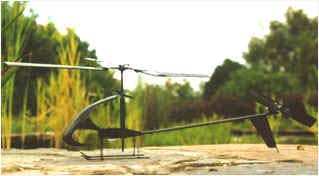|
Just tried harder
|
 |
Characteristics Overview
Rotor: 35 cm
Weight: 99.5 grams (3.5 ounces) with 8 cell 50mAh, can fly on 6 cells at 91 grams
Radio: 4 channel FM, Futaba 9Z (TX), CETO (RX)
Speed Controllers: 0.7 gram WES
Flight time: 2 minutes with 50 mAh pack, 3 minutes with 75 mAh
Materials used: all carbon, except mainrotor (balsa covered with ultra-light glass-fiber cloth)
First flight performed on Saturday 23 Aug. 1997 in ...my livingroom
 |
Pixel II was developed to do better than Pixel I. Because now I had a point of reference, it became actually easier than I thought. My target was to go under 110 grams, eventually 105. To plan that, I made an inventory list of all individual components of Pixel I with their respective weight and set next each of them a target weight for Pixel II. I decided that I would only build the next component if the one I was working on would have met or done better than the target. That method worked better than expected. It forces you to be very creative. For example, the tailrotor was 2.9 grams, the new molded version only 0.9 gram. |
 |
This is Takashi Tanaka, test pilot for Hirobo Japan, holding
Pixel II. Picture is taken by Mr. Hiroshi Tamura, R&D Mgr. for Hirobo. Both were in
the Hirobo Europe offices. I flew Pixel II for them, and it was particularly satisfying for me to be able to amaze the Japanese with 'small' things. This honor is usually up to them when they do it to us. They took a truckload of pictures, and I don't care...I can live for years on their spontaneous applause after the flight. |
 |
Close up of the 'warroom'. Watch the carbon fiber canopy at
1.5 grams. Gear transmission is still 2 stage. Blue spots are the two 2.7 gram WES servos.
To the left of the mast and above the motor is the reworked Piezo Gyro. I drilled holes in
the PC board, changed components with lighter ones and ended up at 4.7 grams. Whole frame is still in carbon fiber. The rods and the tubes I bought from WES. I now molded myself great looking glossy carbon sheets by squeezing cloth/epoxy between glass plates. I made them in different thickness. Lightest is one layer of 100gr/sqm. Handling is easy, can be cut with hobby knife, or even scissors. |
 |
See the small SR sticker, testifying that their batteries
indeed power Pixel II. Power pack is 8 cell 50 mAh (not shown) for 2 minute flight. SR is
not regularly available over here, but I got everything through Internet/E-Mail from them.
Got very good service. My second pack are Sanyo
cells from WES, and they work equally well. You can see all the cables go to one spot under the canopy. That is where the CETO FM receiver is. If you find lighter and better than that (4.1 gram with antenna and X-tall !), let me know... |
 |
Pixel II in flight in our offices. Flight is incredibly stable. Here you can detect under the canopy the SR batteries in their typical white heathschrink. The model does not vibrate, does not oscillate, does not wobble, it just hangs there (still need to hold the sticks a bit though...) |
 |
One can see the coning of the mainrotor. Coning is far less though than with Pixel I, mainly because of different design of the rotorhead. Pixel I had a full-flapping rotorhead (blades can go up and down independently from each other on a hinge). Pixel II has a rigid rotor, with the centerpiece that has some flexing capability. A side effect of all my development work is that I start understanding much better how a rotorhead determines control &stability, |
 |
This gives an idea about size. Transmitter is a Futaba 9Z. Only 'fancy' feature used on the radio was the 5 point tailrotor mix program that let my fine-tune mixing between the rotorspeed and the tailrotor speed. I strapped Pixel II on a small platform that could yaw about the vertical axis, supported by two ball-bearings. Then I set up the mixing curve such that the tail did not move when going from full Idle to full throttle. I don't remember ever having flown a Heli with a tail that was more rock solid on it's position than with Pixel II. |
| Go to top of 'Pixel II' page | |